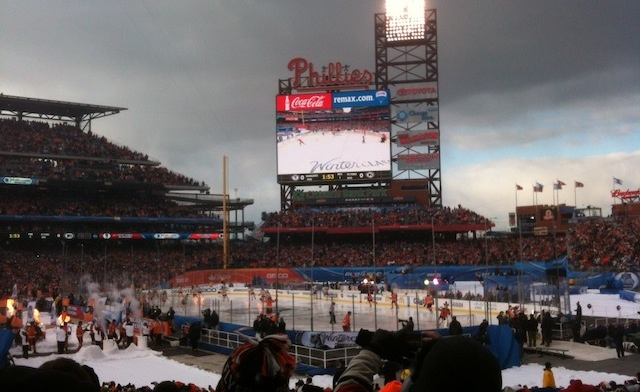Outdoor allure: Why we love the Winter Classic

It started to flurry sometime in the middle of the second period of the 2012 Bridgestone Winter Classic. Just a few wispy, genuine flakes swirling down across a baseball field covered in cottony, fake snow and temporary ice. More than an appearance by The Roots, an array of what appeared to be flaming white trash cans, or the complimentary Winter Classic seat pads (thanks, Bridgestone), the subtle snow seemed intent on reminding a baseball park full of hockey fans why they were freezing their asses off to watch the Philadelphia Flyers and the New York Rangers play outside in January.
As a singular tiny, crystalline bit landed on my knee, I thought for a brief, poetic moment that hockey truly is meant to be watched outside, through the fog of warm breath in the frosty air…
Then I ran out of hot chocolate, my toe warmers stopped working, and the jet lag of a 13-hour flight from Tel Aviv to Philly set in. My next shivering thought, perhaps preconditioned by nearly three years of California residency: What am I doing here?
When I finally warmed up, about five hours, two hot chocolates, and a car seat butt warmer later, I started thinking about the oddity that is outdoor hockey as we know it. After all, hockey lore holds that the sport was born in the great Canadian outdoors. How twisty and strange is it that now indoor hockey, at one time a technological marvel, seems to be the game’s obvious home, while the outdoor origins of the game are such a sparkling novelty?
Turns out it’s not so bizarre at all. Indoor ice rinks have been around for awhile — at least since the mid-1800s. And maybe every other hockey fan already knows this, but the game, with the rules and parameters we know and love today, was not even born on an outdoor sheet. Organized hockey is said to have been born in 1875 within the confines of the indoor Montreal Victoria Skating Rink. According to the International Ice Hockey Federation, “It was the first known game which was pre-announced, where two named teams played on a confined ice area (a rink), where all names of the players were recorded as well as the score and the game was played with ‘a flat circular piece of wood,’ a puck.”
Although the game at Victoria Skating Rink didn’t mark the end of outdoor play, it did herald a significant shift. The last international games to take place on outdoor, natural(ish) ice were the 1957 World Hockey Championships in Moscow, where maybe the weather was so arctic it seemed ludicrous to even consider an indoor arena. The final championship game between the Soviet Union and Sweden drew a record attendance: 50,000 spectators. (To put that in perspective, the 2012 Winter Classic pulled in 46,967 and both Philadelphia and the NHL were thrilled.)
Since then, despite the evident popularity, the incidence of professional outdoor hockey games has been relatively few and far between: a 1962 game in Gothenburg, a 1991 game in Vegas (of all places), the infamous Michigan “Cold War” in 2001, the Edmonton “Heritage Classic” in 2003, and the start of the Winter Classic games in 2008 in Orchard Park, New York, are some of the most famous. With far flung teams in enormous leagues and finicky man-made ice, the indoor sport makes way more sense. And yet people still convince themselves that outdoor hockey is the real, authentic hockey — how the game was “meant to be” — despite the fact that this sentiment makes no historical sense. After all, pond hockey is a far cry from what amounts to an inside-out ice skating rink parked in whatever lucky football or baseball stadium has the honor of hosting thousands of eager fans. I’ve played backyard pond hockey — the Winter Classic was awesome, but it was not that.
And I guess, when you think about it, that’s exactly why so many people love to go: outdoor hockey is awesome. It’s an excuse for a total spectacle, the complete package. People don’t actually fork over hundreds of dollars to see outdoor hockey games and connect with the roots of a beloved sport. If they really wanted to do that they could take a vacation to Saskatchewan. Hockey fans buy expensive tickets, expensive team jerseys, and gallons of hot chocolate because they’re there to see an outrageous show: The Roots, the flaming white trash can thingies, the gently falling snowflakes, and of course, a spectacular game that’s “meant” to be played wherever there are a pile of adoring fans clamoring to see it.
—
Yael Borofsky is a writer, editor, and Philadelphia sports fan living in San Francisco. Follow her on Twitter @yaelborofsky.
Comments
2 Responses to “Outdoor allure: Why we love the Winter Classic”Trackbacks
Check out what others are saying...-
[…] game I followed anywhere besides Twitter was — I say this both sheepishly and proudly — the Winter Classic. Other than that, it seems that for the last month my entire hockey universe existed on Twitter. […]
Hey, did you see that Detroit and Toronto get next year’s Winter Classic at the Big House in Ann Arbor? :)